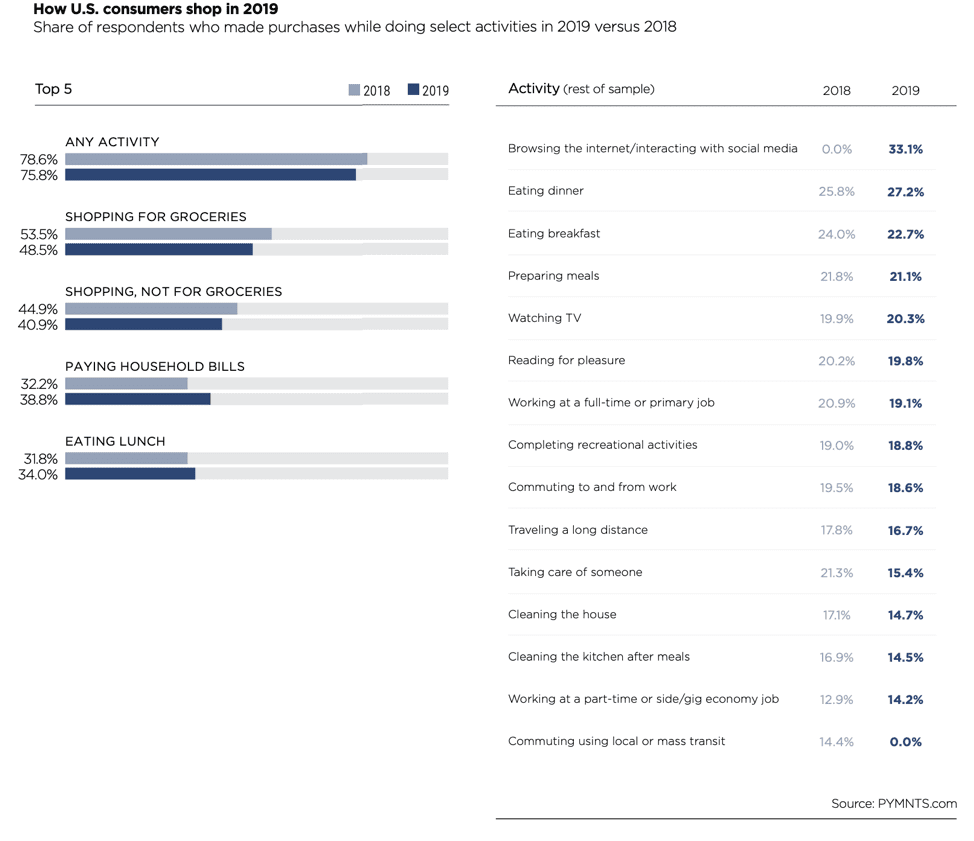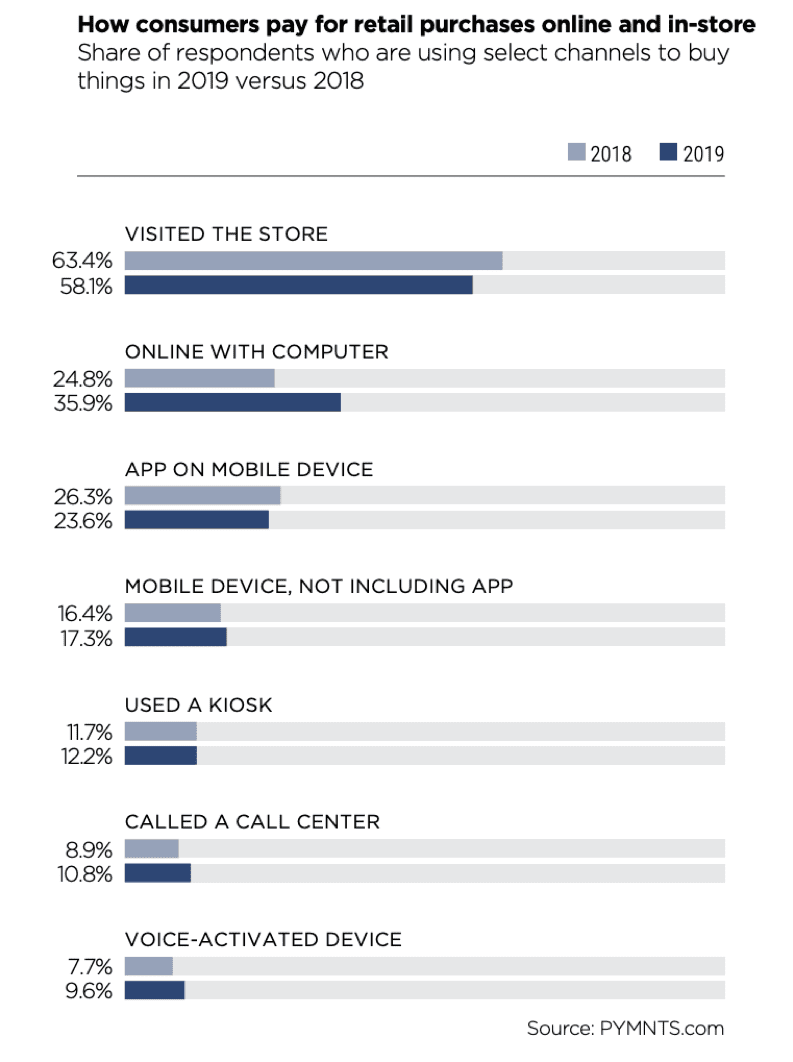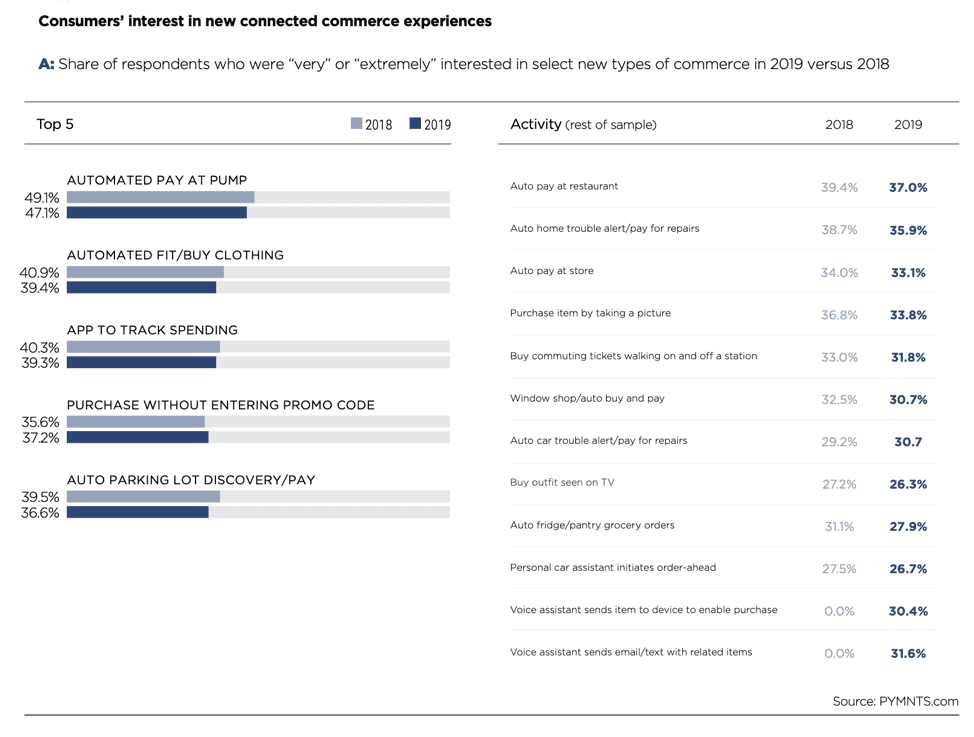Is There Anywhere Connected Consumers Won’t Shop?

It was recently reported that one in 15 purchases are now made between the hours of midnight and 6 a.m. (at least in the U.K.)
According to PYMNTS’ new How Will We Pay 2019 report, this is not surprising. Going shopping has taken on new meaning. Consumers are now shopping anywhere, at any time — even while eating and working.
From virtual reality to connected cars to artificial intelligence (AI), the retail industry is being transformed by new technology and emerging omnichannel models that allow consumers to shop more easily.
Mastering Multi-Tasking
Roughly three-fourths (75.8 percent) said they make at least one purchase while doing another activity. Close to half (48.5 percent) make purchases while shopping for groceries while 40.9 percent do when shopping for items other than food.
That makes sense, but 27 percent of consumers also say they shop while eating dinner and 20 percent shop while watching television. Roughly one-in-five also shop while commuting to work or even while at work.

Much of this multi-tasking is being driven by the increasing adoption of connected devices. These devices not only give consumers more opportunities to make purchases during the course of their day-to-day activities, but also give consumers more options to do so while at home.
In 2019, ownership of smartphones increased by about 6 percentage points year-over-year, from 84 percent in 2018 to 90 percent. Ownership of voice assistants is also up, with now roughly one in three consumers in the U.S. owning one.
Home Is Where the Cart Is
Consumers were asked which of 15 different routine activities they performed at home, and which they performed at stores, restaurants, bars and other brick-and-mortar establishments. Their responses show that for seven of these activities, the share who perform them at home is higher in 2019 than in 2018.
The biggest increases were with working gig jobs, watching television and paying household bills. Thirty-five percent of consumers with ad hoc employment worked from home in 2019, representing a 29 percent increase from last year.
Consumers might be staying home to get things done, but it is not stopping them from making purchases. About one-quarter of consumers in the study reported making purchases using their computers in 2018, with 24 percent using mobile apps and 7.7 percent using voice-activated devices.
Last year, consumers reported that buying in the physical store was still how most purchases were made. This year, there was a shift. Now 58 percent (8.4 percent fewer) of consumers make purchases in a physical store, while 36 percent use computers, 26 percent use mobile apps and 9.6 percent use a voice-activated device.

Why Consumers Like Connected Commerce
Over the past few years, not only has the number of devices that connect to the internet expanded — so have devices and apps designed to remove friction when buying things. This barrage could result in app fatigue, but many consumers are still interested in new connected commerce experiences. This year, a majority of consumers (52 percent) report making more purchases via connected devices, up from 43 percent in 2018.
Why? Most indicate interest in saving money (85 percent), to reduce the frustration of standing in line (83 percent) and to enhance data security (82 percent).
As to specific types of new connected commerce, automated pay at pump was tops this year (47.1 percent) as well as in 2018. Many of these newer types of commerce appear to be car-related. Automated parking lot spot finders and payments had interest from over one-third (36.6 percent) of consumers while an in-car voice assistant to order ahead also had interest from one-quarter (26.7 percent).
Other wanted experiences were more fanciful like purchasing an item by taking a picture (33.8 percent) and buying outfits seen on TV. Automated fit for clothing isn’t completely mainstream, but it was the offering that received the next highest interest levels (39.4 percent) after automated paying for gas.

Who Owns Innovation?
When consumers were asked to name which brands they trust to innovate these new connected commerce experiences, the list was wide-ranging, including banks, card networks, FinTechs, tech companies and retailers.
The most popular were Visa (44 percent), PayPal (43 percent), Amazon (40 percent), their banks (33 percent) and Mastercard (32 percent). Facebook came in last on the list (9.1 percent) with the consumers’ favorite retailers faring only slightly better (9.4 percent).
It would be a fair conclusion to say that as connected commerce experiences proliferate, consumers have some reservations about Google or Apple leading the charge. Many will look to card networks and their banks to power the FinTech experiences that make up their connected commerce lives.
